Dam Maintenance
-
- The Quest to Fund Inland Waterways Marine News, Feb 2015 #18
Infrastructure Projects: Perhaps Not So Quixotic After All?
Over the course of 2014, significant steps forward were taken in the quest to find additional sources of funding for inland waterways infrastructure projects.
First came the long awaited and much-celebrated Water Resources, Reform and Development Act of 2014 (WRRDA) in June, which included several provisions to address the funding needs of the ever-worsening condition of the inland waterways infrastructure. WRRDA eased the burden of the Olmsted Locks and Dam on the Inland Waterways Trust Fund (IWTF) by reducing the IWTF’s share of the costs for Olmsted from 50% to 15%. WRRDA also expedited the process by which the U.S. Army Corps of Engineers is to study and carry out new construction and rehabilitation projects for the inland waterways infrastructure.
WRRDA and more
WRRDA laid the groundwork for additional sources of funding in two other respects. First, Section 2004 of WRRDA, captioned “Inland Waterways Revenue Studies,” requires the Secretary of the Army to conduct two studies. One study is to examine the “potential benefits and implications of authorizing the issuance of federally tax-exempt bonds secured against the available proceeds, including projected annual receipts, in the Inland Waterways Trust Fund.” A separate study is to explore the “potential revenue sources from which funds could be collected to generate additional revenues for the Inland Waterways Trust Fund.”
A second provision, Section 5014, is captioned “Water Infrastructure Public-Private Partnership Pilot Program,” and requires that the Secretary establish a “pilot program to evaluate the cost effectiveness and project delivery efficiency of allowing non-Federal pilot applicants to carry out authorized water resources development projects for coastal harbor improvement, channel improvement, inland navigation, flood damage reduction, aquatic ecosystem restoration, and hurricane and storm damage reduction.” More on this provision later.
A final development in increasing the funding for inland waterways infrastructure projects came at the very end of the year: the inclusion in the so-called “tax extenders” legislation of an increase in the tax assessed on diesel fuel used on the inland waterways from 20 cents per gallon to 29 cents per gallon, which takes effect on April 1, 2015. These fuel taxes go into the IWTF, and some industry sources have estimated that the fuel tax increase will generate approximately $40 million in additional revenues for the IWTF every year. If these additional revenues are applied directly to construction and rehabilitation projects, they will bring substantial benefits to the inland waterways infrastructure. Even further, such additional revenues could be leveraged through, say, bond financing to achieve even more dramatic results. A study prepared for the United Soybean Board by the Center for Ports and Waterways of the Texas Transportation Institute, titled “New Approaches for U.S. Lock and Dam Maintenance and Funding,” published in January 2013, explains and illustrates how this could be done. The study can be found at www.soytransportation.org.
Stakeholder Buy-In
This eleventh-hour increase in the fuel tax was almost as surprising as it was welcome. For the past several years, the inland waterways industry has been recommending this increase. This recommendation was included in the Capital Projects Business Model prepared by the Inland Marine Transportation System Capital Investment Strategy Team, which was unanimously approved and adopted by the Inland Waterways Users Board in 2010. In 2013, the Waterways Council and a coalition of nearly 40 stakeholders expressed their support for increasing the fuel tax to at least 26 cents per gallon in a letter to the House Ways and Means Committee.
Early in 2014, Congressman Dave Camp (R MI), chairman of the House Ways and Means Committee, included an increase of six cents in this tax in his draft of the Tax Reform Act of 2014, but his proposal to overhaul the tax code made little headway in the House of Representatives. Despite this discouraging track record in attempting to obtain the fuel tax increase over the past several years, the industry succeeded in getting the increase of nine cents included in the tax extender legislation, which arrived—even without help from FedEx or UPS—just in time for the holidays.
Toward the end of the year an initiative at the state level got under way as well. This is an effort to take advantage of public-private partnership provisions of WRRDA to preserve the authorization of the Navigation and Ecosystem Sustainability Program (NESP). NESP is a long-term program authorized by Congress in the 2007 Water Resources Development Act for navigation improvements and ecological restoration for the Upper Mississippi River System and the Illinois Waterway navigation system, following years of study by the U.S. Army Corps of Engineers, going back to 1989, and collaboration among Illinois and the other states in the Upper Mississippi River System. The primary goal of NESP is to implement an integrated, dual-purpose plan to ensure the economic and environmental sustainability of the Upper Mississippi River System and the Illinois Waterway navigation system by reducing commercial traffic delays while restoring, protecting, and enhancing the environment. Congress last appropriated funding for NESP in 2011. Under current law, NESP could be de-authorized if it does not receive funding in 2016, undoing years of study and multi-state collaboration.
Specifically identified as included within NESP are several locks and dams on the Illinois River, since this waterway connects the Great Lakes with the Upper Mississippi River and commodities shipped on the Illinois River can be transshipped via the St. Lawrence Seaway to Canada and Europe, or via the Mississippi to the Upper Midwest or to the Gulf of Mexico and beyond. Although the full scope of NESP encompasses all of the states within the Upper Mississippi River System, an appropriation by Congress of funds by 2016 for a construction project for one or more of the locks and dams on the Illinois River that are specifically identified in NESP would avoid the de-authorization of NESP for lack of funding.
Public-Private Initiatives
Enter WRRDA Section 5014 and the Water Infrastructure Public-Private Partnership Pilot Program. Section 5014 allows for the transfer of federally authorized projects to a non-federal sponsor for design, financing, construction, operations and maintenance. The State of Illinois, through its legislature and its Department of Natural Resources, which has responsibility for waterways within the State of Illinois, is evaluating whether to serve as the sponsor for a new public-private regional authority that would become the non-federal sponsor for this program under WRRDA Section 5014.
Then-Governor Pat Quinn of Illinois notified the U.S. Army Corps of Engineers in a letter that Illinois would begin to address the need for an innovative delivery model to upgrade the locks and dams on the Illinois River through the use of a public-private partnership as authorized in WRRDA.
Those working on this initiative have designated it as the “Illinois and Middle Mississippi River Public-Private Partnership Pilot Program,” or IMMR P5. The initial focus will be on the locks and dams within the State of Illinois as the first phase of the program, in order to save the time that would otherwise be required to establish interstate agreements with Iowa and Missouri for the locks and dams on the Mississippi River between Illinois and each of those other two states. If the first phase is successful, then the program would be expanded to a tri-state organization among Illinois, Iowa and Missouri as additional segments of the Upper Mississippi River System are added to the program.
The first practical step would be the formation of an Inland Rivers and Waterways Working Group, under the auspices of the Illinois Department of Natural Resources, with the expectation that it would transition into an Inland Rivers and Waterways Authority that would serve as the non-federal and local sponsor of the program under WRRDA Section 5014.
Failure is Not an Option
Legislative support for this initiative is being led by both Illinois State Senator David Koehler, Chair of the Agriculture Conservation Committee of the Illinois State Senate, and Illinois State Senator Martin Sandoval, Chair of the Transportation Committee of the Illinois State Senate. On December 2, 2014, a subject matter hearing was held before the combined committees on the issues currently needing to be addressed for the locks and dams on the Illinois River and on the feasibility of the IMMR P5 approach. Representatives of the Illinois Department of Natural Resources, of the U.S. Army Corps of Engineers, of the Illinois Soybean Association, of the environmental and engineering consulting firm CH2M Hill, of the Nature Conservancy, and of several environmental advocacy organizations presented testimony. Senator Koehler chaired the hearing.
In his opening remarks, Senator Koehler summarized the importance of the inland waterways to the economic health of Illinois and the nation, and the need to address the continuing deterioration of the inland waterways infrastructure. Following the testimony of certain environmental advocacy organizations who expressed opposition to facilitating commercial navigate on the inland waterways, Senator Koehler asked, “Is anyone here suggesting that we do nothing?” When no one responded in the affirmative, he said, “Good – because that is not one of the options.”
(As published in the February 2015 edition of Marine News - http://magazines.marinelink.com/Magazines/MaritimeNews)
-
- WRRDA: Charting a New Course Marine News, Jul 2014 #26
for the United Soybean Board by the Center for Ports and Waterways of the Texas Transportation Institute, titled “New Approaches for U.S. Lock and Dam Maintenance and Funding,” published in January 2013 (the TTI Study). In the discussion of section 2004 in the Conference Report for WRRDA (H. Rep. 113-449
-
- WRRDA: Clearing the Channel for P3 Projects Marine News, Nov 2014 #40
for the United Soybean Board by the Center for Ports and Waterways of the Texas Transportation Institute, titled “New Approaches for U.S. Lock and Dam Maintenance and Funding,” published in January 2013 (the USB Study). (A copy of the USB Study can be found, among other places, on the website of the Soy
-
 )
March 2024 - Marine Technology Reporter page: 41
)
March 2024 - Marine Technology Reporter page: 41Image courtesy Outland Technology Image courtesy Exail Image courtesy Submaris and EvoLogics Vehicles The ROV-1500 from Outland Technology represents a leap forward in underwater robotics, a compact remotely operated vehicle (ROV) weighing in at less than 40 lbs (19kg) the ROV- 1500 is easy to transport
-
 )
March 2024 - Marine Technology Reporter page: 36
)
March 2024 - Marine Technology Reporter page: 36LANDER LAB #10 Of special interest for marine applications, LiPo batteries are Shipping any kind of lithium battery can be a challenge, and offered in a “pouch” design, with a soft, ? at body. The pouch IATA regs vary with the batteries inside or outside an instru- is vacuum-sealed, with all voids ?
-
 )
March 2024 - Marine Technology Reporter page: 19
)
March 2024 - Marine Technology Reporter page: 19to adjacent structures, e.g., drain to wells, using simple visualizations such as heatmaps. The to well from anodes on X-mas trees), and Coating damages, larger scope, e.g., combining pipelines and structures within a with position and current supplied. subsea ? eld on one survey mobilization
-
 )
March 2024 - Marine Technology Reporter page: 18
)
March 2024 - Marine Technology Reporter page: 18evaluating cathodic protection this process there is a risk that possible issues like coating (CP) systems offer only a momentary glimpse into their sta- damages are not discovered. This can happen because some tus. This limitation compels operators to schedule CP inspec- of the signal peaks are interpreted
-
 )
March 2024 - Marine Technology Reporter page: 17
)
March 2024 - Marine Technology Reporter page: 17• Integrity assessment, and otherwise covered, e.g., by rock dump. As for depletion of • Mitigation, intervention and repair. sacri? cial anodes, this can be dif? cult or even impossible to Selecting the best method for collecting the data these work- estimate due to poor visibility, the presence of
-
 )
March 2024 - Marine Technology Reporter page: 16
)
March 2024 - Marine Technology Reporter page: 16TECH FEATURE IMR Image courtesy FORCE Technology OPTIMIZING CATHODIC PROTECTION SURVEY USING NON-CONTACT SENSORS By Svenn Magen Wigen, FORCE Technology he principle behind sacri? cial anodes, which are water structures, reducing the need for frequent repairs and used to safeguard underwater pipelines
-
 )
April 2024 - Maritime Reporter and Engineering News page: 14
)
April 2024 - Maritime Reporter and Engineering News page: 14Book Review Approach to Meeting Underwater Radiated Noise Limits Def ned By Raymond Fischer uantitative underwater radiated noise limits will construction inspections, 5) possible training with respect to be developed shortly by IMO, and/or countries salient design/construction essentials, 6) compliance
-
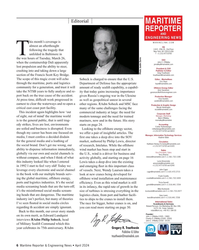 )
April 2024 - Maritime Reporter and Engineering News page: 6
)
April 2024 - Maritime Reporter and Engineering News page: 6Editorial MARITIME REPORTER AND ENGINEERING NEWS his month’s coverage is M A R I N E L I N K . C O M almost an afterthought HQ 118 E. 25th St., 2nd Floor following the tragedy that New York, NY 10010 USA T +1.212.477.6700 Tunfolded in Baltimore in the wee hours of Tuesday, March 26, CEO John C.
-
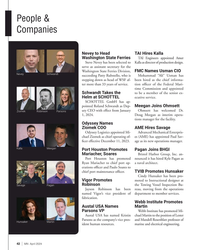 )
April 2024 - Marine News page: 42
)
April 2024 - Marine News page: 42People & Companies Nevey to Head TAI Hires Kalla Washington State Ferries TAI Engineers appointed Amer Steve Nevey has been selected to Kalla as director of production design. serve as assistant secretary for the FMC Names Usman CIO Washington State Ferries Division, Nevey Schwandt succeeding Patty
-
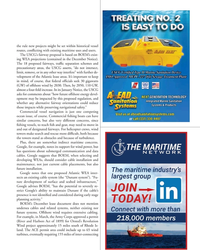 )
April 2024 - Marine News page: 23
)
April 2024 - Marine News page: 23the rule new projects might be set within historical vessel routes, con? icting with existing maritime uses and users. The USCG’s fairway proposal is based on BOEM’s exist- ing WEA projections (contained in the December Notice). The 18 proposed fairways, traf? c separation schemes and precautionary
-
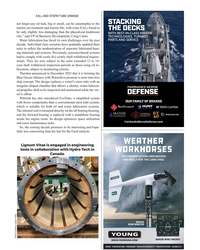 )
February 2024 - Maritime Reporter and Engineering News page: 33
)
February 2024 - Maritime Reporter and Engineering News page: 33EAL AND STERN TUBE DAMAGES STACKING not forget any oil leak, big or small, can be catastrophic to the marine environment and marine life, with some EALs found to THE DECKS be only slightly less damaging than the phased-out traditional WITH BEST-IN-CLASS MARINE oils,” said VP of Business Development
-
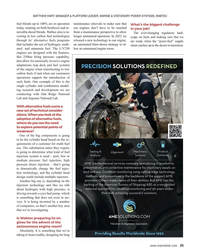 )
February 2024 - Maritime Reporter and Engineering News page: 25
)
February 2024 - Maritime Reporter and Engineering News page: 25MATTHEW HART, MANAGER & PLATFORM LEADER, MARINE & STATIONARY POWER SYSTEMS, WABTEC fuel blends up to 100% are in operation maintenance intervals to make sure that What’s the biggest challenge today, running on both biodiesel and re- our engines don’t have to be touched in your job? newable diesel blends.
-
 )
February 2024 - Maritime Reporter and Engineering News page: 24
)
February 2024 - Maritime Reporter and Engineering News page: 24R&D marinized version of the V228 product from 8 to 16 cylinders. through improved lifecycle cost, trade-offs, it also allows us That engine is called the V228 for the bore size in millimeters. to do concurrent design and reliability demonstrations. We’re With the advent of emissions regulations for EPA
-
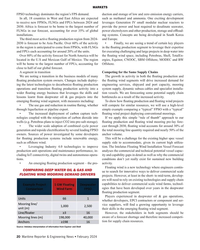 )
February 2024 - Maritime Reporter and Engineering News page: 20
)
February 2024 - Maritime Reporter and Engineering News page: 20MARKETS FPSO technology dominates the region’s FPS demand. duction and storage of low and zero emission energy carriers, In all, 18 countries in West and East Africa are expected such as methanol and ammonia. One exciting development to receive new FPSOs, FLNGs and FPUs between 2024 and leverages
-
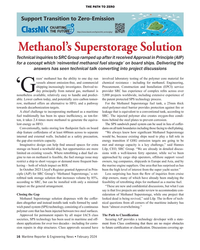 )
February 2024 - Maritime Reporter and Engineering News page: 16
)
February 2024 - Maritime Reporter and Engineering News page: 16corrosion. lent energy as HFO. The SPS sandwich panel system can be used in lieu of coffer- Conventionally, tanks storing low ? ashpoint fuels on board dams on all tank boundaries including those facing to shell plating. ship feature cofferdams of at least 600mm across to separate “We always knew how
-
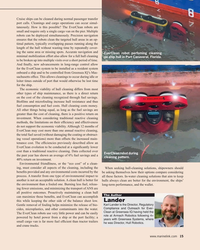 )
February 2024 - Maritime Reporter and Engineering News page: 15
)
February 2024 - Maritime Reporter and Engineering News page: 15do not support the economic viability. Although 12 months of EverClean may cost more than one annual reactive cleaning, the total fuel saved (without damaging the coating or obstruct- ing vessel operations) more than offsets the increased main- tenance cost. The ef? ciencies previously described allow
-
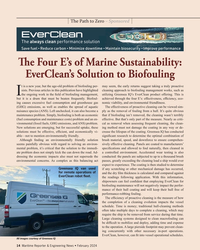 )
February 2024 - Maritime Reporter and Engineering News page: 14
)
February 2024 - Maritime Reporter and Engineering News page: 14ANS) problem. cal as removal when assessing frequent cleaning, the clean- New solutions are emerging, but for successful uptake, these ing method must not damage the coating in any way or de- solutions must be effective, ef? cient, and economically vi- crease the lifespan of the coating. Greensea IQ has conducted
-
 )
February 2024 - Maritime Reporter and Engineering News page: Cover
)
February 2024 - Maritime Reporter and Engineering News page: Cover2024 MARITIME REPORTER AND ENGINEERING NEWS marinelink.com ARC KEEPING THE CARGO ROLLING Repair & Maintenance Since 1939 | Number 2 | Volume 86 Stern Tube Damage Declining? Marine Power R&D Mat Hart, Wabtec Shaf Generators Demand on the Rise Floating Production Growth & Transition COV1 MR Feb 2024 v3
-
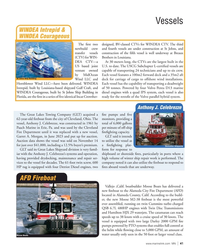 )
February 2024 - Marine News page: 41
)
February 2024 - Marine News page: 41Vessels WINDEA Intrepid & WINDEA Courageous The ? rst two designed, BV-classed CTVs for WINDEA CTV. The third newbuild crew and fourth vessels are under construction at St Johns, and transfer vessels construction of the ? fth vessel is well underway at Breaux (CTV) for WIN- Brothers in Louisiana.
-
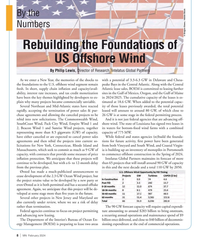 )
February 2024 - Marine News page: 8
)
February 2024 - Marine News page: 8By the Numbers © Dragon Claws / Adobe Stock Rebuilding the Foundations of US Offshore Wind By Philip Lewis, Director of Research, Intelatus Global Partners As we enter a New Year, the memories of the shocks to with a potential of 3.3-6.3 GW in Delaware and Chesa- the foundations to the U.S. offshore wind
-
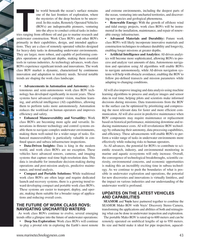 )
January 2024 - Marine Technology Reporter page: 43
)
January 2024 - Marine Technology Reporter page: 43he world beneath the ocean’s surface remains and extreme environments, including the deepest parts of one of the last frontiers of exploration, where the ocean, venturing into uncharted territories, and discover- the mysteries of the deep beckon to be uncov- ing new species and geological phenomena. ered.
-
 )
January 2024 - Marine Technology Reporter page: 37
)
January 2024 - Marine Technology Reporter page: 37an online dashboard will convey ? ndings and share stories. GETTING UNDERWAY Sailing to remote parts of the ocean between June and Oc- “A modern-day warrior is not about war. It’s about the per- tober, Ocean Warrior intends to cover 10,000 nautical miles son—honesty, integrity, empathy, intelligence
-
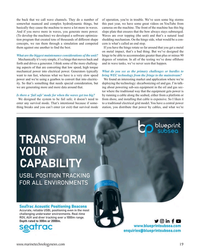 )
January 2024 - Marine Technology Reporter page: 19
)
January 2024 - Marine Technology Reporter page: 19the back that we call wave channels. They do a number of of operation, you’re in trouble. We’ve seen some big storms somewhat nuanced and complex hydrodynamic things, but this past year, we have some great videos on YouTube from basically they cause the machine to move a lot more in waves. cameras on
-
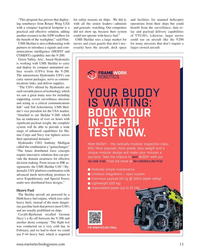 )
January 2024 - Marine Technology Reporter page: 13
)
January 2024 - Marine Technology Reporter page: 13“This program has proven that deploy- for safety reasons on ships. We did it, and facilities for manned helicopter ing sonobuoys from Rotary Wing UAS with all the senior leaders—admirals operations from their ships but could with a compact logistical footprint is a and generals--watching. Our competito
